Convair F2Y-1 Sea Dart - supersonic seaplane
World War II has just ended, in which heavy aircraft carriers manifested themselves in all their glory. But they had two significant drawbacks: Huge size, and as a consequence, the high cost of construction and operation, as well as vulnerability in battle. Especially about this began to talk after the appearance of nuclear weapons.
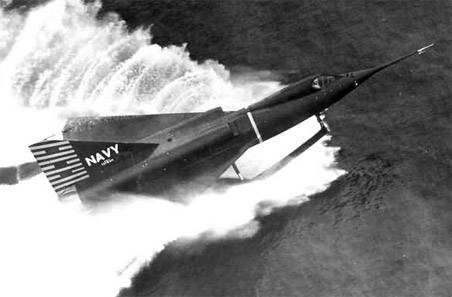
Indeed, with the sinking or damage of an aircraft carrier, his entire air group broke down, and these are many dozens (up to a hundred) of aircraft. The onset of the jet era entailed a further increase in the size of the required aircraft carriers, which in turn led to an increase in their value. To break this vicious circle, the idea to create a fighter - a seaplane. It could be based on small ships, similar to the landing craft, having a camera - dock. It was assumed that the aircraft would be launched from the upper deck with the help of a catapult, and after completing the assignment, it would land on the water and taxi into the camera - the dock.
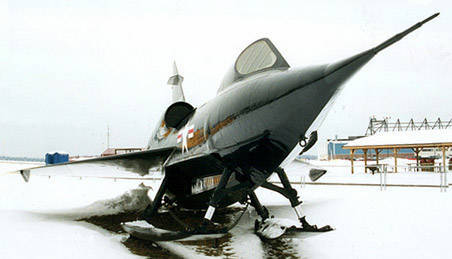
An important invention was aviation hydro ski. This idea arose in the minds of employees of the Steven Institute of Technology and NACA (National Advisory Committee on Aeronautics, not to be confused with NASA, which was created on its basis later - in the 60s).
Studies have shown that the ski can lift the plane out of the water. At the same time, there will be no need for redan, on which the plane glides through the water in the second stage of the takeoff, and this will protect the fuselage from water impacts and, after cleaning the skis, will improve aerodynamics. The decisive experiment conducted on the Grumman JRF-5 Goose flying boat showed the practical applicability of hydrolines and the ability to provide the necessary stability and controllability during take-off and landing.
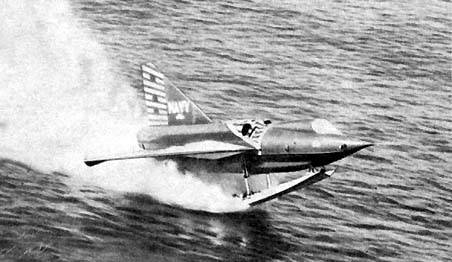
At the end of the 40s, Convair proposed a number of unusual seaplane projects, one of which had a so-called “mixed hull”. The concept of a mixed hull suggested that the plane was sitting deep in the water, its wings touch the surface and are involved in creating overall buoyancy (there are no supporting floats). Approach in the design of the company Convair assumed the creation of a perfect hydrodynamic model, so that later, on its basis, to create a highly efficient aircraft.
1 October 1948 g, BuAer - Maritime Bureau of Aeronautics, - announced a competition to create a seaplane - a fighter plane, which was supposed to have a speed of X 0,95, could take off from a wave, 1,5 m high and perform interception at night. By November, 1949 had put forward operational requirements from the command of the Navy. They envisaged the creation of a fighter - a hydroplane capable of operating from forward bases in any weather conditions. It was intended to fulfill these requirements using hydrolifts.
Conveer has launched extensive work including numerous wind tunnel blows, towing in the David Taylor Model Basin, as well as high-speed studies in the Laboratory of Atmospheric Physics. The company decided to use the deltoid (triangular) wing in Russian literature, which was formed during the creation of the YF-102 interceptor, which promised to show the speed of 1,5 М, at the height of 9100. The fighter-aircraft fighter received the preliminary designation Y2-2.
19 January 1951 signed a contract with Convair for two prototypes. These two prototypes were designated XF2Y-1 and the registration numbers of BuAer 137634 and 137635.
The power plant was to consist of two Westinghouse J46-WE-2 TRDs, which were allowed to be replaced by J34-WE-32, if the latter did not have time to start the flight tests. In August, the aircraft 1951 received the designation XF2Y-1 (X - means experimental, F - fighter).
And in February 1952 of the year, a contract was signed to supply 12 serial F2Y-1 Xi Darth (Sea Dart), the 1954 g.NVM was so confident in the success of the machines that ordered the 12 serial aircraft before the tests ended, therefore (so far as understood) 14 October 1953 second experimental XF2Y-1 (BuNo 137635) was destroyed, plainly and not participating in the trials.
Later, the delivery dates and the number of ordered machines changed several times, but in the end 3 flight machines and 2 models were built for research and testing.
For the first time, C Dart was launched on December 14 1952. Then, water tests began at the Convair testing station in San Diego Bay. The aircraft taxied on the water, gradually increasing speed.
Once, on January 14 1953, during a high-speed run, the plane accidentally broke away from the water, after running in the 310 m. But officially the first flight was made a little later. The reason for the delay was an unpleasant and potentially dangerous phenomenon, which the Americans called "Shelling of the skis."
According to the reports of the pilots, it began at speeds of more than 96 km / h, and resembled getting into the skis of a machine-gun queue or driving on a washboard. The vibrations were so strong that it was not possible to read the readings of the instruments, and once the LDPE bar in the nose of the aircraft broke off, which led to the failure of many flight instruments.
Studies have shown that the reason lies in the irregularities of the water surface, which with force hit the skis. The crests of the waves greatly enhanced the blows. Vibration from the water in a complex way interacted with the deformation of the skis and oscillations of the suspension struts. Sometimes the system of ski - stand - water entered into a resonance. To reduce the "shelling of the skis", the straight rear edge of the skis was replaced with a pointed one and the depreciation characteristics were changed. The shape of the ski in the plan also changed. Shelling has decreased, but never in the future has been completely overcome.
The first official flight of Sea Dart was made on 9 on April 1953. By this time the clouds on the Sea Dart program began to move in from the other side: after a few months of flight, the land interceptor Conver YF-102, with a delta wing similar to that of Sea Dart, did not want to overcome sound barrier. The same problems threatened XF2Y-1.
The situation was aggravated by the not entirely optimal design of the air intakes and the tail section in the area of the engine nozzles. In addition, the J46-WE-2 engines, which were finally installed on the plane, did not give the promised thrust. As a result, the design speed of M 1,5 was reduced to disappointing M 0,99, which was significantly less than required fleet M 1,25.
As an excuse, one could say that no aircraft at that time could fly faster than the M 0,9. The firm Konver conducted pioneering work in the field of high speeds. Interceptor YF-102A, after 4-x months of test flights, still broke the sound barrier.
But before that, it was remade in accordance with the "rule of squares". This inspired hope in relation to Sea Dart, but the naval authorities still in the long term saw a very small Sea Dart speed and continued "shelling of the skis." (Let me remind you that the "Rule of areas" is that the cross-sectional areas of the aircraft, made along its longitudinal axis, should change smoothly.
Best of all, if the graph of transverse areas is a part of a circular arc or a part of ellipse. If it is simpler to say - in the place of attachment of the wing the aircraft fuselage should have a narrowing. Then, the impedance, at transonic and supersonic speeds, will be minimal.)
At the end of 1953, when the war in Korea ended and the cuts in military spending began: Xi Darth was the first candidate to cut. The order for the series was canceled, and all were built 3 aircraft, one layout and a machine for static tests.
However, flight tests were continued. The XF2Y-1 aircraft received improved J46-WE-2B engines with an afterburner. The engine was longer, the nacelle was lengthened and the fuselage tail fairing was changed. The tests focused on reducing the shelling of the skis. C Darth No.1 flew in the original configuration with a pair of skis, until the middle of 1954.
XF2Y-1 Xi Dart No.2 began testing at the beginning of 1954. The plane had many changes, including significant ones: the fuselage became longer, the span and area of the wing increased. The nozzles of the engines were better adapted to the tail fairing of the fuselage.
The plane had a pair of skis, but the wheels were missing, so for moving C Dart No.2 they used an erratic trolley. Shortly after the flight began, a wing flutter appeared, which was quickly cured. C Darth No.2 was the only aircraft in which the flutter appeared. While the first Ci Dart was used for skiing, the 2 number was used for high-speed flights.
It worked out a control system with boosters and studied stability and controllability in various flight modes. During the 3 flight in August 1954, the pilot Richburg in a gentle dive from a height of 10300 m exceeded the speed of M 1. Thus, XF2Y-1 Xi Dart was the first, and so far the only seaplane flying supersonic.
Around the end of 1954, Conver, inspired by the success of the “space rule,” proposed to design a new C Dart F2Y-2. He should have one ski, fuselage, made according to the rule of the squares and the power plant with a single TRD Pratt & Whitney J75 or Wright J67.
According to calculations, F2Y-2 should have shown the speed M of 2. But the fleet did not share the optimism of the company and refused to consider any proposals of fighters - seaplanes, until the problems with the "shelling of the skis" were resolved.
Meanwhile, Sea Dart No. 2 continued testing on the high seas south of Point Loma. Tests on the open sea required the use of various means of support: numerous boats, a landing ship - the dock type LSD Kate Mount, as well as a rescue helicopter and aircraft. Tests at sea showed low suitability of hydrolines for action in the open sea, especially during rough seas.
At the end of 1954, C.Dart No.1 was redesigned and equipped with a single ski. She had a low deadrise and was fastened under the center section on four strut struts. The monolage was wide enough to fasten two wheels on its trailing edge, which, with the aft wheel, allowed the aircraft to be towed.
All were investigated about 100 options for different skis. But, as is often the case, the solution of some problems causes the appearance of others. The “shelling of the ski” on the new aircraft was significantly less (although it did not completely disappear), but dangerous rocking of the aircraft in pitch arose and the stability of the aircraft on the course deteriorated. A partial solution to these problems was achieved by improving the depreciation struts. They have become with variable stiffness. Depending on the impact speed, the number of open holes varies, allowing oil to pass through in the strut. The solution is difficult, but promising, so the aircraft began to be prepared for evaluation tests with representatives of the fleet.
But before the evaluation tests began, the next blow struck the program. 4 November 1954, the industry together with the fleet, prepared a demonstration for the press and television representatives of the new aircraft: the vertical take-off attack aircraft XFY Pogo and the transport plane R3Y Treydvind. C Dart was not preparing for the show. But the reporters demanded to show them the latest fighter - a seaplane. Well - well, we decided to fly ...
Before the flight, Charles Richborg was instructed: Just take off, pass in front of the podium at the height of 300 ... 400 m, and then gently splashed about. Nothing more is required of you. Everything was approximately the same, but during the passage, at an altitude of 300 mC, Dart was dispersed to a speed of about 920 km / h, and right in front of the podium he suddenly collapsed in the air and collapsed into the water as a fireball. Charles Richborg was still breathing when he was caught by a rescue boat, but after a few minutes he died.
The commission investigating the catastrophe established that the tragedy had nothing to do with the characteristics of C Darth as a seaplane. It was the imperfection of the then control systems with hydraulic drives. In flight, increasing fluctuations in pitch occurred, with which the control system could not cope.
The situation was aggravated by involuntary microscopic movements of the pilot’s hand. Such fluctuations occurred on several high-speed aircraft at that time, so this was not a disease of only Sea Dart. Simply, Richborg was unlucky, his C Dart collapsed due to large aerodynamic loads during the second deflection of the aircraft's nose down. (Maybe our well-known designer A.N. Tupolev, who said at about that time, was right: “The best booster is the one that is not installed on the aircraft).
All flights on Sea Darta were immediately suspended. Although ski testing tests were resumed immediately after the preliminary findings of the emergency commission were made public. But speed flights F2Y never performed again.
Meanwhile, 4 March, 1955, the last flight copy of Ci Darth No.3 took off. He had double skis, which feature was the method of mounting the wheels on the pointed rear edge of the skis. The wheels were turning, and the axis of rotation was along the ski. After taxiing on the ground, the wheels turned to 90grad. and with its plane they became one plane with the ski, thereby making the entire surface of the skis smooth.
The main task of the aircraft No.3 was working out double skis in the open sea. The results were not very encouraging. To accelerate the take-off and reduce the time for “firing the skies”, we decided to try powder starting accelerators RAT0, with 440 kgf and 13-15 working hours p. A pair of such accelerators were installed under each wing of the F2Y-1 3 number. The takeoff was successful, but this work did not receive further continuation. The double-ski trials were completed on April 28, and no more Sea Dart No.3 went up into the air.
But Sea Dart No.1 with mono-skid continued flying. At the same time, there was another problem - the deposition of salt on different parts of the aircraft. Especially dangerous was the deposition of salt on the blades of the compressor. Salt did not appear from the spray, but stood out from the salty sea air. When the engine was running, deposits could come off and damage other vanes. To prevent this, they decided to rinse off the salt with water. By aircraft No.No. 1 and 3 was installed a fresh water tank with a capacity of 76 l.
When the engine was running on low gas, before take-off, water was fed to the compressor inlet, which washed off the salt. This system worked very efficiently. Another series of tests was devoted to determining the max vertical speed during landing. She managed to bring to 5,8 m / s, while the aircraft behaved satisfactorily.
Interest in the fighter-seaplane at the customer gradually faded away. Sea trials in the meantime continued.
A typical flight was made according to the following scheme: On the ground, the engine was started, and on its own wheels, mounted on skis and a lower keel, the plane taxied to a slip. The wheels were equipped with brakes, controlled from the cockpit with two levers on the right console, rather than traditional pedals.
Pilots considered such a decision unsuccessful, but control was never lost. With simultaneous braking of the wheels, the plane slowed down, and when separated, it turned in one direction or another. During the ground taxiing, the skis were released in the first position so that their planes were parallel to the longitudinal plane of the aircraft.
After lowering the plane into the water, the wheels on skis turned to 90grad., So as not to protrude beyond the plane of the skis. Water taxiing was not difficult, using a combined steering wheel - a brake at the end of the fuselage. If necessary, it was possible to turn around sharply, using different engine thrust. On the other hand, it was noticed that with one engine running, C Dart was not keeping up well on a given course.
Under normal conditions, on a small gas, the hydro-fighter sailed at a speed of 2 - 3 knot (3,7 ... 5,5 km / h), with open steering wheel and fully released skis, the speed dropped to 1 ... 2 knots (1,8 - 3,7 km / h) Driving to the point of take-off, the pilot had to balance the wind and sea currents. Before the start of the ski run, they were completely released using the button at the back of the left hand transmitter.
The run was performed approximately parallel to the wave front, with the nose inclined to the wind, as far as possible. During the tests, C Dart took off with a side wind to 60grad. from the course of takeoff.
With the gas, the aircraft accelerated and left the water on skis at speeds from 8 to 10 nodes (15 -18,5 km / h). To eliminate pilot errors and perform the correct take-off by engineers, Konver developed an automatic ski control system during run-up and run. After the fuselage emerged from the water (15 - 18,5 km / h), the full afterburner was blocked, and the skis were retracted to the towing position.
At the same time, their immersion in water decreased and hydrodynamic resistance decreased. The plane began to accelerate faster. The blockage of the afterburner was removed, and at a speed of approximately 50 nodes (93 km / h) the skis were fully released again. Thus, a steady gliding of the aircraft over the water, with minimal “shelling of the skis”, was achieved.
At a speed of 100 nodes (185 km / h), the angle of attack was 2grad. - 5grad., And at a speed of 125 nodes (231 km / h) reached the take-off value 17grad. -19grad., At which the gap occurred. In the speed range from 96 km / h, to 231 km / h take-off and sea roughness up to 0,6 m, the plane experienced “shelling of skies” with sharp blows and overloads to 5,5 d, with a frequency of 15-17 Hz.
In the air, the plane behaved normally, without any special features, although the control system with hydraulic boosters was not yet fully developed. An overview of the cabin with an unusual, wedge-shaped glazing was sufficient, although it was proposed to enlarge it in a series. In some positions, the illumination of the instrument panel was recognized insufficient, which made it difficult to read the readings of the instruments.
The powerplant, even with the J46-WE-2B engines with an afterburner, was insufficient, so the throttle response and rate of climb of the aircraft was considered not brilliant for the fighter. Along the way, the sensitivity of J46-WE-2B to salt deposition in the flow path was found out - the quality is not good for a "sea" TRD. Protection of the air intake from splashing was generally resolved, and during operation, with the implementation of the relevant regulations, the engine had to work out the full resource.
Landing hydraulically fighter occurred in reverse order. The skis were fully produced (in the 2 position) and the plane was planning to water. The touch occurred at a speed of 120 nodes (222 km / h). The plane glided through the water and braked rather quickly, gradually plunging into the water. When the speed was less than 6 knots (10 km / h), the skis were transferred to the towing position, and the wheels were turned to the working position. On them, the plane could slip ashore using its own engines.
The last time C Dart took to the air on 16 on January 1956, the goal was to determine the maximum nautical qualities of the aircraft. The excitement at sea was 5 points (wave height to 3 m), with strong wind (37 km / h) blowing roughly 45grad. to the wave front. Billy Long, the pilot of the aircraft, during the run-up, in order to get rid of the shaking and “shelling of the skis” faster, blew up the plane early. As a result, the car jumped up and flopped again on the water, after which it began to “goat” or, as they say in our hydroaviation, “do leopards”. The blows were very hard, and the overloads reached dangerous 8,5 d.
At the same time, the only thought of Long was to prevent the plane from diving into the wave and, if possible, taking off. Finally, Sea Dart No.1 broke away from the water. Gaining height and making a circle over the bay, Billy went to the landing. She also did not differ grace and was accompanied by a series of strong blows. At the same time, Long hit his head on the glazing and smashed his nose to blood. Despite this, he managed to keep the plane from diving under water, and on the run, C. Dart stopped quickly and returned safely to San Diego. It was the last flight of the Sea Dart (Sea Dart).
The final blow to the program was caused by the appearance of “super-racers” (as the Americans called them because of the huge displacement in 60000 / 75000 t in those times) of the Forrestal type. Thus, Sea Dart lost the competition to a heavy aircraft carrier, which he, if successful, was going to replace. In January, 1956. The Department of Naval Operations removed technical requirements for a seaplane fighter, and the program was closed.
LTH:
Modification of YF2Y-1
Wingspan, m 10.26
Length, m 16.03
Height, m 6.32
Wing area, m2 52.30
Weight, kg
empty 5793 aircraft
normal takeoff 7497
Engine type 2 TRD Westinghouse J34-WE-32
Traction unformed, kgf 2 x 1542
Maximum speed, km / h 1118
Cruising speed, km / h 980
Practical range, km 826
Maximum rate of climb, m / min 9965
Practical ceiling, m 15300
Crew 1
Armament: Combat load - 907 kg (calculated)
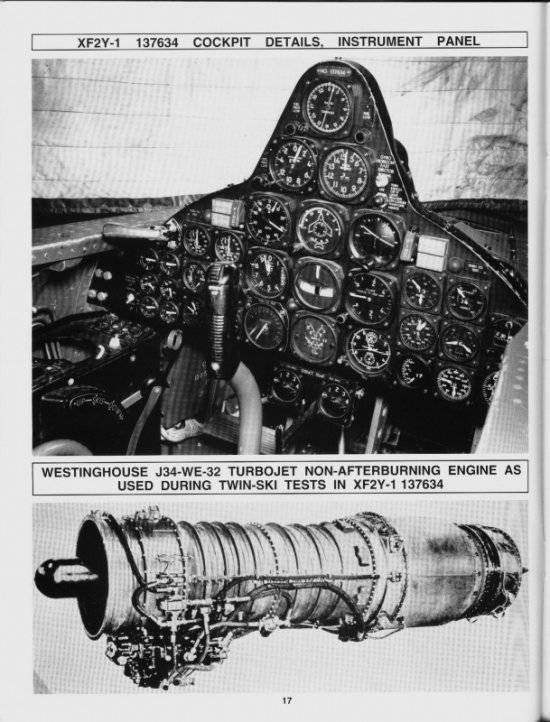
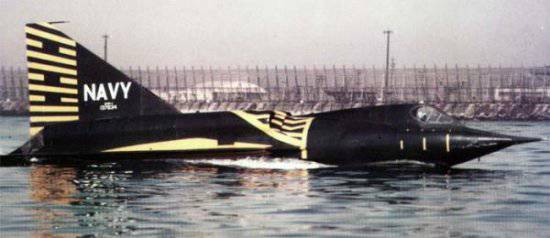
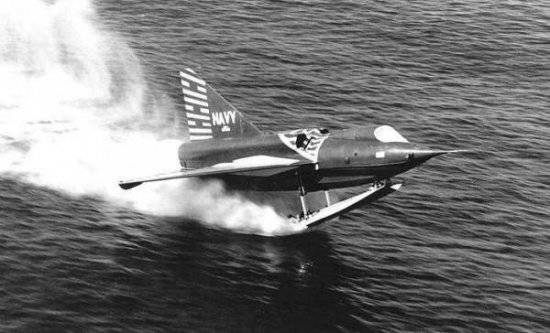
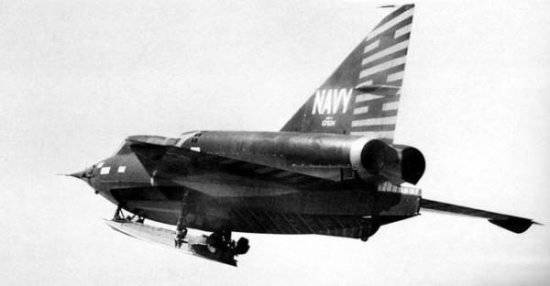
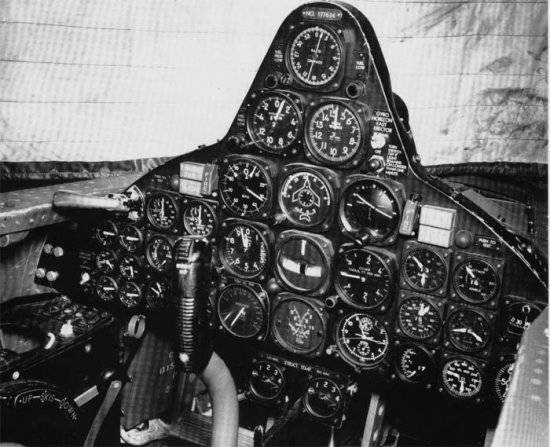
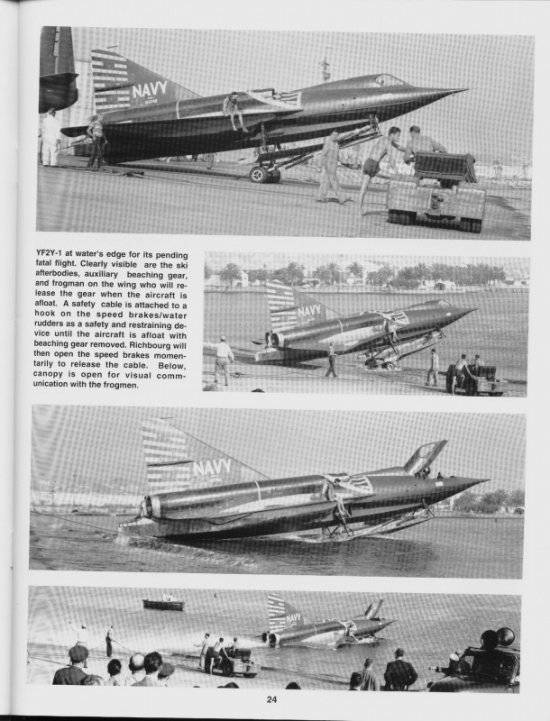
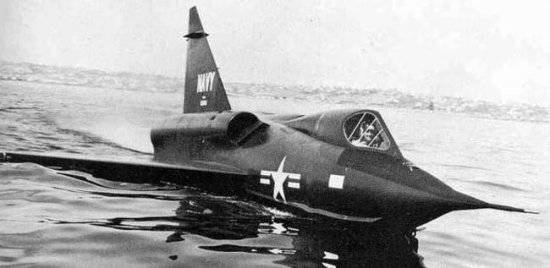
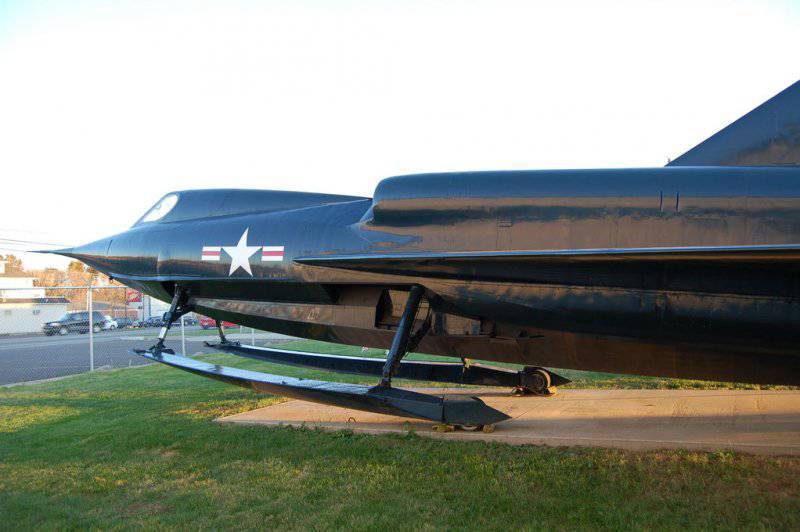
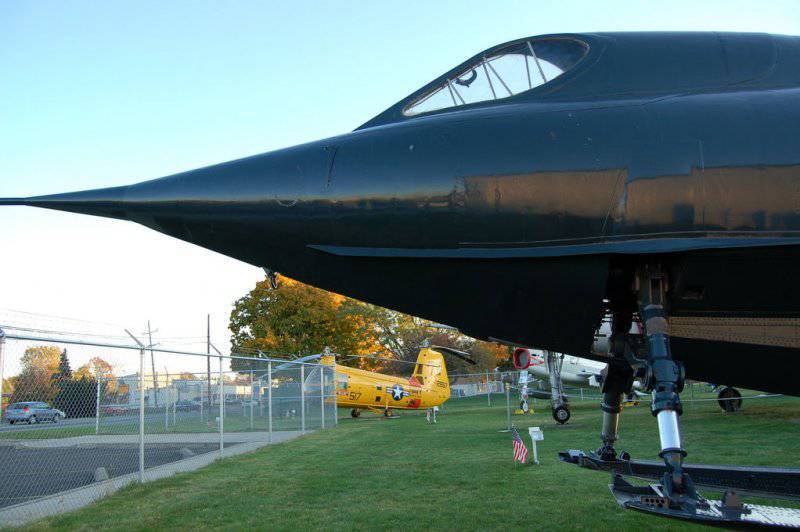
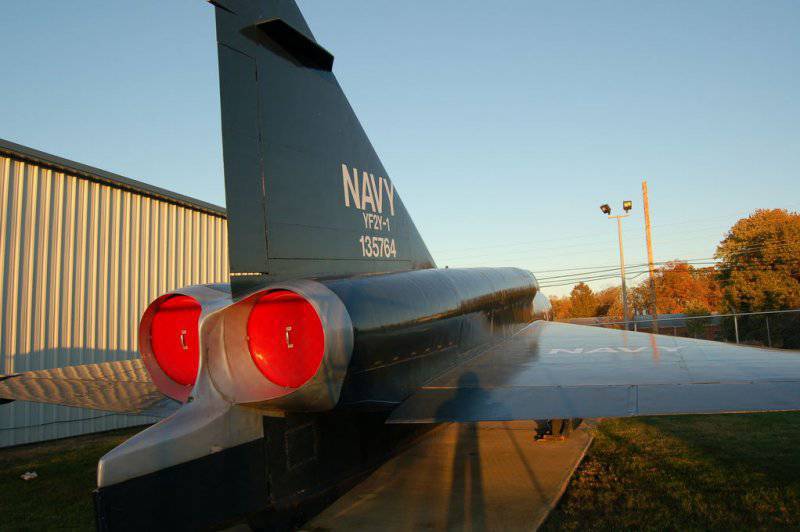
Information